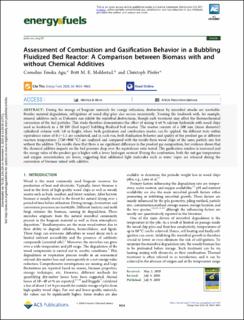| dc.contributor.author | Agu, Cornelius Emeka | |
| dc.contributor.author | Moldestad, Britt Margrethe Emilie | |
| dc.contributor.author | Pfeifer, Christoph | |
| dc.date.accessioned | 2021-02-03T13:15:20Z | |
| dc.date.available | 2021-02-03T13:15:20Z | |
| dc.date.created | 2020-12-28T13:06:03Z | |
| dc.date.issued | 2020 | |
| dc.identifier.citation | Agu, C. E., Moldestad, B. M. E. & Pfeifer, C. (2020). Assessment of Combustion and Gasification Behavior in a Bubbling Fluidized Bed Reactor: A Comparison between Biomass with and without Chemical Additives. Energy & Fuels, 34(8), 9654-9663. | en_US |
| dc.identifier.issn | 0887-0624 | |
| dc.identifier.uri | https://hdl.handle.net/11250/2726012 | |
| dc.description.abstract | During the storage of biogenic materials for energy utilization, destructions by microbial attacks are inevitable. Besides material degradation, self-ignition of wood chip piles also occurs consistently. Treating the feedstock with, for example, mineral additives such as Dolomite can inhibit the microbial destructions, though such treatment may affect the thermochemical conversion of the fuel particles. This study therefore demonstrates the effect of mixing 4 wt % calcium hydroxide with wood chips used as feedstock in a 20 kW (fuel input) bubbling fluidized bed reactor. The reactor consists of a 100 mm (inner diameter) cylindrical column with 1.0 m height, where both gasification and combustion modes can be applied. Six different tests within equivalence ratios of 0.1–1.1 are conducted, and in each run, both fluidization behavior and quality of the product gas at different reaction temperatures (750–900 °C) are analyzed and compared with the results from wood chips of the same particle size but without the additive. The results show that there is no significant difference in the product gas composition, but evidence shows that the chemical additive impacts on the bed pressure drop over the equivalence ratio tested. The gasification window is increased and the energy value of the product gas is higher with a lower hydrogen content. During the combustion, both the exit gas temperature and oxygen concentration are lower, suggesting that additional light molecules such as water vapor are released during the conversion of biomass mixed with additive. | en_US |
| dc.language.iso | eng | en_US |
| dc.rights | Navngivelse 4.0 Internasjonal | * |
| dc.rights.uri | http://creativecommons.org/licenses/by/4.0/deed.no | * |
| dc.title | Assessment of Combustion and Gasification Behavior in a Bubbling Fluidized Bed Reactor: A Comparison between Biomass with and without Chemical Additives | en_US |
| dc.type | Peer reviewed | en_US |
| dc.type | Journal article | en_US |
| dc.description.version | publishedVersion | en_US |
| dc.rights.holder | © 2020 American Chemical Society. | en_US |
| dc.source.pagenumber | 9654-9663 | en_US |
| dc.source.volume | 34 | en_US |
| dc.source.journal | Energy & Fuels | en_US |
| dc.source.issue | 8 | en_US |
| dc.identifier.doi | https://doi.org/10.1021/acs.energyfuels.0c01408 | |
| dc.identifier.cristin | 1863516 | |
| cristin.ispublished | true | |
| cristin.fulltext | original | |
| cristin.qualitycode | 2 | |

